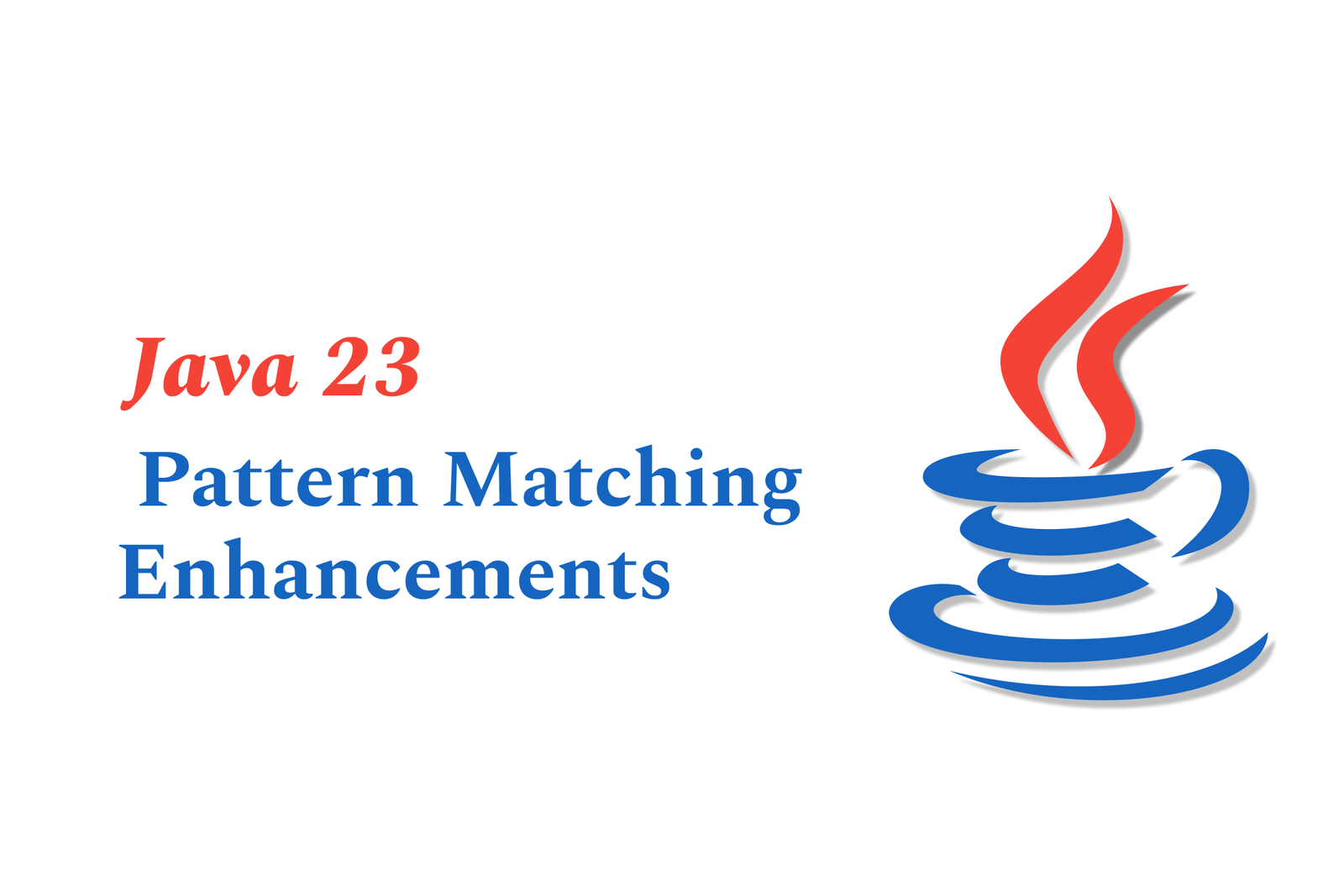Java 23 pattern matching enhancements
Java 23 enhances pattern matching by extending support in `instanceof` and switch statements, improving type safety, allowing primitive and record patterns, and simplifying null handling. These upgrades enable more concise, readable, and expressive code for type-based logic.
Java 23 Pattern Matching Enhancements
1 ) Introduction to Pattern Matching in Java
Pattern matching tests if an object fits a specific structure and extracts data if matched.
Java previously supported this via `instanceof`, with enhancements to make code more concise and robust.
Patterns serve as conditions in expressions/statements to test target objects.
Example: `s instanceof Rectangle r` tests if `s` is a Rectangle and assigns it to `r`.
2 ) Pattern Matching with `instanceof` and Switch
`instanceof` with pattern matching declares pattern variables initialized on successful match.
Patterns appear in switch case labels, enabling clean handling of multiple types.
Example switch with pattern matching:
java
switch (s) {
case Rectangle r > return r.length() * r.width();
case Circle c > return c.radius() c.radius() Math.PI;
default > throw new IllegalArgumentException("Unrecognized shape");
}
This removes boilerplate casting and improves readability.
3 ) Type Patterns and Record Patterns
Type pattern: a type plus a pattern variable (e.g., `Rectangle r`).
Record pattern: matches record types by extracting components directly.
Example: matching a record `Point`:
java
record Point(double x, double y) {}
if (obj instanceof Point(double a, double b)) {
// a and b initialized directly
}
This simplifies deconstruction and variable extraction from records.
4 ) Advancements in Java 23’s Pattern Matching
Enhanced pattern matching for switch statements allows type safe, concise handling of multiple types without verbose if else chains.
Support for primitive types in pattern matching within `instanceof` and switch statements increases expressiveness and reduces boilerplate.
Enhanced null handling in switch pattern matching adds robustness.
Record and sealed types are fully supported in pattern matching contexts.
5 ) Benefits for Developers
More readable, concise, and maintainable code when handling type specific logic.
Reduction of explicit casts and manual extractions.
Improved potential for behind the scenes optimizations due to well defined pattern structures.
Seamless integration in modern Java programming, especially in complex control flow.
6 ) Practical Use Cases
Dynamically processing inputs based on runtime type in microservices.
Simplifying complex conditional logic in data deserialization and validation.
Leveraging clean syntax to destructure immutable records easily.
7 ) Conclusion
Java 23 expands and refines pattern matching features, making it a powerful tool for developers to write clearer, safer, and more efficient code. The enhancements in pattern matching within `instanceof` and switch statements, along with support for record patterns, mark a significant step towards expressive and robust Java programming.
https://justacademy.in/news-detail/android-new-api-releases
https://justacademy.in/news-detail/how-react-native-is-evolving-with-the-latest-tech
https://justacademy.in/news-detail/flutter-forward-2025-recap
https://justacademy.in/news-detail/android-file-management-app-innovations
https://justacademy.in/news-detail/react-native?s-role-in-ai-powered-mobile-experiences
Related Posts
Java supports GDPR and data privacy by enabling secure data handling through encryption, controlled access, and precise data management. It allows developers to minimize PII exposure, ensure data confidentiality, and design workflows that comply with data protection regulations effectively.
Java code quality tools have evolved to include advanced static analysis, integrated security checks, and AI-powered code reviews. These updates help developers detect bugs, enforce coding standards, and enhance security, streamlining the development process and improving overall code reliability.
Java remains a cornerstone in big tech companies, evolving with modern features like records, pattern matching, and virtual threads. Its robust ecosystem, enhanced performance, and growing AI integrations keep it vital for both legacy systems and innovative new projects.
Java and CI/CD pipeline optimizations streamline Java application development by automating builds, tests, and deployments. They improve efficiency through parallelization, caching, and secure secrets management, enabling faster feedback loops and more reliable, scalable software delivery.
Java supports modern cryptography standards through its flexible Java Cryptography Architecture (JCA), enabling integration of advanced algorithms like AES, EdDSA, and post-quantum tools. Libraries like Bouncy Castle offer FIPS-certified, hardware-accelerated implementations for secure development.
Java 23 enhances record patterns by enabling concise, direct destructuring of record components within pattern matching, simplifying type checks and data extraction. This improvement boosts code readability and expressiveness by reducing boilerplate in handling immutable data classes.
Java remains a top choice for mobile app backends, powering scalable, secure, and high-performance server-side solutions. Latest trends include cloud-native microservices, reactive programming, and enhanced JVM optimizations, enabling efficient, flexible, and robust mobile backend development.
Java SE 24 and LTS Java SE 21 offer enhanced features and performance, while Apache Spark 4.0.0 introduces Scala 2.13 support and advanced ML and SQL capabilities. Together, they empower developers to build scalable, high-performance data applications with modern tools.
JUnit 5 modernizes Java testing with a modular architecture, improved assertions, and seamless Java 8+ support. Beyond JUnit, tools like Mockito and AssertJ enhance mocking and assertions, creating a powerful, flexible ecosystem for writing clean, efficient Java unit tests.
Java plays a pivotal role in cloud automation tools by providing a robust, platform-independent language used to build scalable automation frameworks like Jenkins and Selenium, enabling efficient CI/CD pipelines, testing, and orchestration across diverse cloud environments.










